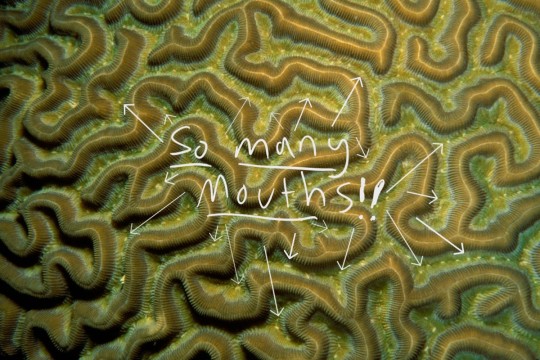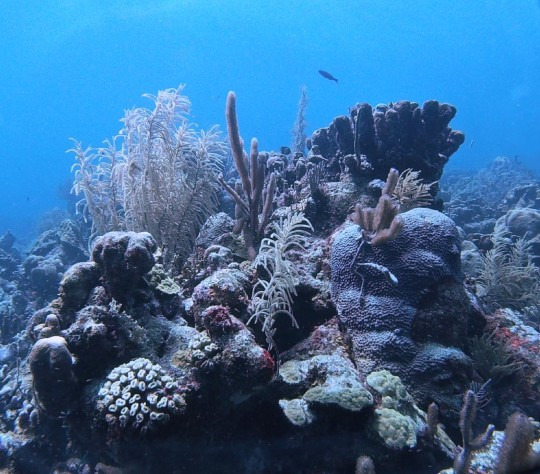#in the grand scheme of the world i believe coral reefs as an ecosystem type will survive
Note
Tell me about corals magic man
oh man this ask keeps sitting here and I keep starting to write stuff out, forgetting it, then never finishing. So since I am still processing tons of coral pics from a recent field work excursion about coral (and have a day off to just CHILL at home before regular work again) this is as good a time as any.
CORAL. IT'S IMPORTANT I GUESS BUT WHAT THE FUCK IS THAT? PLANT?? ANIMAL??? OVERAMBITIOUS ROCK???
Yes. kind of. Technically just an animal is correct. Corals are animals, but they are fucking weird animals. Weird in the way that only marine invertebrates can get. I love them because they're freaks. Let me show you.
Corals are a cnidarian, which puts them in the same category as anemones and jellyfish, and when you look at an individual coral polyp you can instantly see the relationship. They are colonial animals with massive structures formed out of polyps that are all clones of each other, and all building a support structure to form the whole, called the colony. An especially cute metaphor I've heard is that each coral polyp has it's own little nook like a room in the massive home they all work to build. A layer of tissue connects polyps to each other over the colony, allowing them to share nutrients and such over the entire structure like little marine communists.
These polyps can range widely in size, and they can either be distinctly separate or all fused together, only distinguished by separate mouths. Numbers can also range from millions to a couple species that will have one or polyp mouths max. Polyps can extend out or retract into their little nook, called the calyx, and extend more when the coral is capturing prey from the water.

Lookit those cute little polyps, these guys make their own cubby for themselves!

Don't worry about what I just said about capturing prey and feeding, look at those cute little guys. Some of them are out and some are retracted, showing the little bump where they live.

Fused polyps like on brain corals don't extend exactly, but feeder tentacles will come out from that delineation between the ridge and oral groove. It's actually called an oral groove! Those tentacles are full of the same stinging cells jellyfish and anemones have! One biologist referred to brain corals as a wall of mouths! Ive seen them using those tentacles to slowly drag struggling little shrimps and larval fish towards a slowly opening mouth amongst that wall of mouths! It's like living in a place where at night, the walls open mouths and drag you into them with unthinking stinging strings! Sometimes they just spit out digestive strings to digest stuff outside of their body, like other coral that got too close and needs to check itself! Isn't that great!
A lot of people are surprised to hear "mouths" and "feeding" with corals and yup, corals are animals and therefore they eat! Each polyp has a mouth and tentacles and will extend them to capture prey, mostly zooplankton but also some plant material. Because they're fucking weird though, many species also gain energy via photosynthesis with the help of a symbiotic dinoflagellate called the zooxanthellae or symbiodinium. It's this algae like symbiont that actually gives coral most of their colors. These colors can range from psychadelic to just brown, with regular old browns and greens and yellows being the most common colors (especially in the Caribbean).
A bleached coral is still alive, but due to stress has lost their zooxanthellae. They can survive and recover, but in this state they are highly stressed, prone to disease, and can starve slowly without the symbionts helping with their nutritional needs. They appear white or faded because the loss of their symbionts reveals the white calcium skeleton beneath the tissue.

Bleached portion of coral beside unbleached.
A dead coral is one that has lost all of it's tissue, and every individual polyp has died, leaving nothing but the skeleton which can no longer grow without the living polyps. Bleached coral is very, very vulnerable to becoming a dead coral.
Unusually high heat is the most common trigger for a bleaching event. And this is where, in my education talks I sometimes do, I pause with a strained grimace of a smile as we all contemplate ocean temperatures hiking up every summer.
SO WHY ARE THESE WEIRDASS ROCK ANIMALS IMPORTANT BESIDES BEING COOL TO LOOK AT?
Coral structure can be colloquially described as stony or soft. Stony corals are what I work with more, and these guys are the ones that build a hard, calcium based structure as their support building, and these powerhouses are the ones that build the coral reef. Soft corals are what it says on the tin, they may have a sort of support structure that varies amongst families, but it's flexible (you'll see them waving very beautifully and gracefully in the currents) and they (for the most part) do not build the reef. If they do add to reef building it, it's with a very slow process of depositing fine layers.
(Soft corals of course have their role in the overall reef health, but reefs are bonkers complicated ecosystems and I'm trying to keep on track here.)
When you're looking at the reef, you are looking on centuries, if not millennia, of stony corals building on top of each other. Sometimes this building has been going on for so long that islands are made of fossilized reefs from millions of years ago, with corals that still resemble modern species in the rock. (This is the case of BonAire and blew my goddamn mind seeing the fossil reef it's so fuckin cool.)

Sometimes just a single colony will keep building on itself into massive structures. Polyp clones adding on and on to their predecessors, giving the colony overall a lifespan in centuries. It's thought that some huge colonies may be thousands of years old, because the fastest growing stony corals have a growth rate that may equal centimeters per year.

It's those reef structures of calcium carbonate building up and up that provide the homes to so many other creatures that coral reefs are some of the most biologically diverse, and biologically dense ecosystems out there, like rainforests of the ocean. Even marine life that doesn't live directly in the reefs have a connection to them, using them as feeding grounds, breeding areas, a place to hide while young and vulnerable, ect.
They even protect coastlines, acting as a literal barrier that reduces wave damage from storms or just wave action in general. The reef takes the brunt of the physical damage, colonies get knocked around, but the still living polyps keep on building and rebuilding so the reef can go on and not get smashed into rubble every year.
That is, if there are still stony corals alive to do the rebuilding. :))))))

So you have these weird animals who build stone structures like cathedrals, have algae in their tissue, live as massive ancient colonies of clones that can eat, photosynthesize, and also reproduce both asexually and sexually. They're able to branch out and do all of that because they are adapted to insanely stable environments. Temperatures don't fluctuate by more than a couple degrees seasonally, tides are consistent, storm seasons are consistent, the water is consistently clear due to lack of algae, which allows sunlight to penetrate and feed the symbionts that feed the coral. Mineral levels in the water are stable so they can take the calcium and carbonate from the sea water to build their skeletons. Without having to be able to adjust to changes in the environment they just went hog fucking wild on all the ways an animal can be an animal.
And here I once again pause with a strained grimace smile as we all take in how they need to be alive to keep building those reefs that support the ocean and the coasts, and how not stable their environment is becoming with new pollutants clouding waters, storms becoming more unpredictable, and waters having bigger temperature swings with hot summer spikes. :)))))))))))
#long post#marine biology#coral reefs#informative#corals are freaks and i love them#i barely touched how theyre freaks i wanted to keep this to a simple 101 guide on what they are and why theyre important#and why they are. not doing too great.#in the grand scheme of the world i believe coral reefs as an ecosystem type will survive#a few species are super hardy#some are more adaptable#in millions of years the ones that made it will eventually find new suitable places to rebuild on the rubble of ruins#but also i would prefer NOT HAVING A CATASTROPHIC EXTINCTION EVENT FOR THEM TO RECOVER FROM OVER A FEW MILLION YEARS THANKS#I WOULD PREFER THAT SORT OF RUIN NOT MAKING LIVES HARDER FOR EVERYONE
75 notes
·
View notes